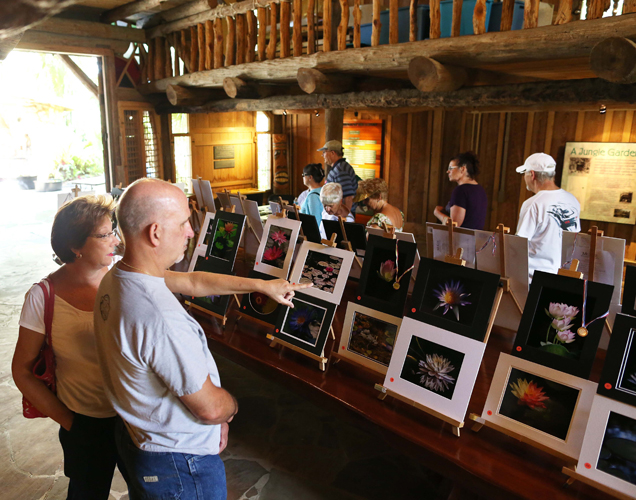
INDIAN RIVER COUNTY — The beauty and diversity of water lilies which have inspired painters, photographers and other artists for centuries was spotlighted during McKee Botanical Garden’s 10th annual Water Lily Celebration.
Hundreds of visitors walked the paths of the gardens to view some 150 varieties of this aquatic plant, which are in bloom during the summer months. These included Foxfire, Surfrider, Bullseye, Colorado, Teri Dunn, Woods Blue Goddess, Madame Ganna Walska and Victoria which bloom in purple, blue, fuchsia, red, peach, yellow and white.
McKee’s magnificent collection naturally displayed in the Zen like tranquility of the water stunned viewers during Saturday’s event, which included a photography contest, repotting and planting demonstrations, aquatic plant sale and vintage garden furniture and accents sale.
Water lilies thrive in heat, so this is the time of year to catch them at the 18-acre gardens located on south US 1.
“Our water lily collection is one of the true showpieces of McKee,” said Christine Hobart, executive director. “This event celebrates the uniqueness of the collection, which is continually changing as we add new varieties, as well as the natural beauty of the garden.”
Visitors admired dozens of black and white, color and manipulated photographs of water lilies that were taken at the garden and displayed in the Hall of Giants before casting their vote for the “People’s Choice” award for both adults and youths.
The adult winner was Krystial Comins, of Port St. Lucie, with her manipulated photograph entitled, “The Garden,” capturing several soft pink water lilies springing from their pads. The youth winner was 14-year-old Jack Frazer Mohler, of Chapel Hill, N.C.
Others brought their cameras and painting materials to participate in the plein air painting session, a French expression which means “in the open air” and is used to describe the act of painting outdoors.
Paintings of water lilies were popularized by the 19th century French impressionist master, Claude Monet who produced numerous studies of water lilies from his famous cottage in Giverny.
Most species of water lilies have rounded pads, variously notched, waxy-coated leaves on long stalks that contain many air spaces and float in quiet freshwater habitats. The fragrant, solitary flowers are borne at or above the water surface on long stalks that are attached to the underground stems.
Some flowers open only in the morning or in the evening to attract insect pollinators.
Andreas Daehnick, director of horticulture, said the water lilies are indeed a special part of McKee’s offerings given their variety. These reside on three-fourths of the garden’s waterways, ponds and streams where they thrive, and there are roughly 300 in total of them. The collection draws from Ohio, North Carolina, South Carolina and South Florida.
One of the things April Littenecker finds so captivating about water lilies is their elusiveness.
“The fact that they are in the middle of the water and you can’t just reach out and touch them,” she said. “They bloom, and then they are gone. You have to catch them quickly or you’ll miss them!”
Edna Carsner, part-time member of the horticulture staff, offered repotting demonstrations while standing in Gator Pond. She showed visitors how to repot water lilies, which McKee staff does each year after they’ve completed their 3-month period in the water. They are put in felt-lined crates and surrounded and fortified with materials such as sand, manure and granular fertilizer for 9 months.
“People are in awe of what they see because of the fact water lilies are so well taken care of here,” Carsner said.



